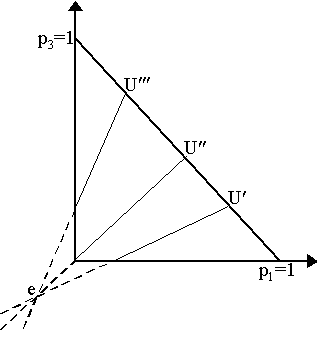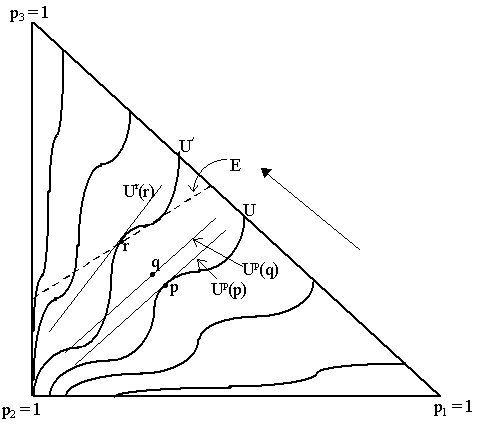|
Contents (i) Weighted Expected Utility The responses to the paradoxes laid out by Maurice Allais (1953) and reinforced by experimental evidence have been of several types. The first argument, pursued by Jacob Marschak (1951) and Leonard J. Savage (1954: p.28-30, 101-3) is that expected utility theory is meant to be a normative proposition, i.e. what rational people people should do under uncertainty rather than what they actually do. This might seem like a weak defense, but as Marschak and Savage argue, the situations proposed in the experiments tend to be rather complicated and unfamiliar so that the subjects made choices in a contrived, uncomfortable scenario which they really did not understand. They argued that if the conductors of the experiment had pointed out the contradictions to their subjects, none of them would have stood by their contradictory choices and would have rectified their responses along the lines of the expected utility hypothesis. However, experimental evidence that accounts for this criticism still casts doubt on the Marschak-Savage argument. (see the collection in Allais and Hagen (1979) for more on this; also Stigum and Wenstop (1982)). The second response has been to attempt to incorporate Allais's "fanning out" hypothesis in to a new theory of choice under uncertainty, thus getting rid of the "paradoxical" nature of the common consequence and common ratio effects. As already shown, the Allais-Hagen incorporation of second and higher moments of lotteries into the utility function would yield this, but their approach was rather "Bernoulli"-like. In other words, Allais (1953, 1979) and Hagen (1972) worked directly with different combinations of the elementary utility functions on outcomes, rather than modifying the underlying axioms of the von Neumann-Morgenstern utility function on lotteries. As a result, Allais-Hagen did not really make it clear that their "fanning out" hypothesis was a result of "rational" behavior. The first steps in this direction were taken the late 1970s and early 1980s. New axioms were introduced such that the Allais hypothesis would emerge as a result. The literature on alternative expected utility has exploded considerably in the 1980s and 1990s. Here we shall only give a heuristic review of two alternative propositions: the Chew-MacCrimmon (1979) "Weighted Expected Utility" and Machina (1982) "Non-Linear Expected Utility". Another notable alternative which deserves special mention but which we do not cover is John Quiggin's (1982, 1993) "Rank-Dependent Expected Utility" (also cf. Chew, Karni and Safra, 1987; Yaari, 1987). A different experimental paradox - what are known as "preference reversals" - has led to the development of "regret theory", which is discussed later. Other alternative expected utility theories (e.g. non-additive expected utility, state-dependent expected utility) are usually discussed within the context of Savage's subjective approach and thus shall be postponed until then. A comprehensive and detailed survey of the literature on alternative expected utility theory is Fishburn (1988); a simpler one is Machina (1987). See also the Stigum and Wenstøp (1983) collection. One of the first axiomatizations of choice theory under uncertainty which incorporates the fanning out hypothesis was the "weighted expected utility" introduced by Soo-Hong Chew and K.R. MacCrimmon (1979) and further developed by Chew (1983) and Fishburn (1983). Without detailing the axioms, the basic result is that Chew-MacCrimmon end up with the following representation of preferences over lotteries:
where, note, u and v are two different elementary utility functions. [other functional forms of weighted expected utility have been suggested by Kamarkar (1978), Kahneman and Tversky (1979)]. For our three-outcome case, this becomes:
so, for any indifference curve, setting U(p) = U* we see that:
The resulting indifference curves are shown in a Marschak triangle in Figure 6.
Several things can be noted. First, indifference curves remain linear as the slope is:
where no probability terms enter. Thus, the linearity of indifference curves in Figure 6. However, the main point of Chew-MacCrimmon is that all indifference curves intersect at the same point. To see this, note that as outcomes (x1, x2, x3) are given, then we have only two unknowns, p1 and p3 in the equation for a single indifference curve. As indifference curves are linear, then, at most, we will have two linearly independent indifference curves. In other words, any two indifference curves will intersect at a point (p1*, p3*). All that remains is to show that this point is the same for any pair of indifference curves. The properties of the utility function of Chew-MacCrimmon have precisely this property, i.e. the solution values (p1*, p3*) do not depend on the levels of acceptable U*, thus all indifference curves will pass through those points. This may sound peculiar, particularly because intersecting indifference curves may seem to violate the transitivity axiom. However, as Chew-MacCrimmon and Fishburn demonstrate, this intersection will be at values of p1 < 0 and p3 < 0, i.e. "negative" probabilities. Thus, the intersection of the indifference curves will be outside the Marschak triangle, as shown by point e in Figure 6. The major consequence, of course, is that the indifference curves are non-intersecting, and thus do not violate transitivity, within the triangle. Thus we do not do violence to rationality while, at the same time, obtain the Allais "fanning out" property necessary to accommodate the common ratio and common consequence effects. (ii) Non-Linear Expected Utility Another celebrated proposition which incorporates the "fanning out" of indifference curves was the non-linear expected utility approach developed by Mark J. Machina (1982). Machina kept the preference ordering axioms and the Archimedean axiom, but dropped the independence axiom - thus not only was the "fanning out" possible, but indifference curves were now non-linear. An example of an indifference map implied by Machina's theory is shown in Figure 7.
There are three distinct features discernible in Figure 7: firstly, indifference curves are generally upward sloping (albeit non-linear); secondly, the direction of increasing preference is to the northwest; thirdly, the indifference curves "fan out". To obtain the upward-sloping nature of the indifference curves Machina appealed to the concept of stochastic dominance. Recall that if outcomes are ranked x3 >h x2 >h x1, then from any distribution p, a change in probability distribution northward or westward implies an increase in the probability weights attached to the more preferred consequences and a decrease in the weights on less preferred consequences. As shown in Figure 7, distributions such as q or r "stochastically dominate" distribution p. As a result, and appealing to continuity, we can trace out an indifference curve U going through p which, although non-linear, is nonetheless upward-sloping. For the two other properties, Machina (1982) appealed to the notion of "local expected utility". What he effectively claimed was that at any given distribution p, there is a "utility function" up which possesses all the von Neumann-Morgenstern properties which is determined by a linear approximation of the true utility function around p. However, we must be clear that up is not a "utility function" in the "function" sense of the term as it is not unique over all distributions - it is specific to p. Thus, Machina suggests up be treated as a "local utility index" determined by the linear approximation around p. A linear approximation around r would yield a different utility index ur. To understand where this comes from, suppose that we have a utility function over lotteries U(p) which yield the non-linear, fanning out indifference maps in Figure 7. As we do not impose the independence axiom, then U(p) does not necessarily have an expected utility representation. However, we can define the local utility index up(x) = ¶ U(p)/dp(x) at a particular x and for a particular p (notice that this requires smooth preferences; cf. Allen, 1987). Thus, up is defined as a linear approximation of the real (non-linear) indifference curve around a neighborhood of p, as we see in Figure 7. We could use it as if it were a regular utility index on a von Neumann-Morgenstern utility function, i.e. we obtain Up(p) = å x p(x)up(x). However, that would just be imposing linearity all over again. Thus, we must restrict the use of the local utility index to points in the neighborhood of its reference point, p. What Machina claimed, then, is that the behavior around p of an agent with a general utility function U(p) can be captured by the local utility index Up(p). Machina (1982) used these local utility indexes to prove the following: firstly, that every local utility function is increasing in x. This effectively guarantees that a small stochastically-dominant shift in a neighborhood of p - say, from p to q in Figure 7 - which we know by linear expected utility implies Up(p) < Up(q), also implies that U(p) < U(q). Thus, the original (non-linear) indifference curves ascend in the northwesterly direction. The more interesting property, however, is the fanning out. This we obtain from Machina's famous "Hypothesis II": namely, that local utility functions are concave in x at each distribution p. What this means is that as we move towards stochastically-dominant distributions, the degree of local risk-aversion increases, i.e. -[up¢ ¢ (x)/up¢ (x)] < -[ur¢ ¢ (x)/ur¢ (x)] where r stochastically-dominates p. This is shown in Figure 7. Recall that "risk-aversion" implies that the indifference curve is steeper than some iso-expected value line (e.g. the dashed line E in Figure 7). We see that the local utility index around r, Ur(r) is steeper than the local utility index around p, Up(p), thus r is more "risk-averse" than p. Thus, as Machina proves, Hypothesis II guarantees the "fanning out" we see in Figure 6. Consequently, as Machina (1982) concludes, the Allais Paradox and all common consequence and common ratio problems can be explained via his rather simple set of axioms. A post-script must be added. These new expected utility theories, as explained, were designed to incorporate the "fanning out" hypothesis and thereby incorporate common consequence and common ratio effects. By design, they seem compatible with early experimental evidence. However, this evidence was collected to test violations of von Neumann-Morgenstern expected utility hypothesis. Only recently has experimental work been designed with these alternative expected utility theories in mind, i.e. to see whether the predictions they make are robust in experimental situations. The results have been coming out more recently and the evidence is mixed (some of the early evidence is reviewed in Stigum and Wenstøp (1983) and Machina (1987)). Some paradoxical findings, such as the "utility evaluation effects", are captured by fanning out. However, other experimental results, such as "preference reversals" (which we turn to next) are not captured by alternative expected utility theory. (iii) Preference Reversals and Regret Theory The Allais Paradoxes -- common consequence and common ratio effects -- are seen as violations of the independence axiom. Another common empirical finding is that of "preference reversal", which is an alleged violation of the transitivity axiom. Evidence for these were first uncovered by psychologists Sarah Lichtenstein and Paul Slovic (1971). The phenomena is captured in the famous "P-bet, $-bet" problem. Specifically, suppose there are two lotteries. These can be set out as follows:
It is assumed that X and Y are large money amounts and x and y are tiny, possibly negative, money amounts. The important characteristic of this set-up is that p > q (the P-bet has higher probability of a large outcome) and that Y > X (the $-bet has a highest large outcome). Thus, the labeling of the bets reflects that people with the P-bet people face a relatively higher probability of a relatively low gain, while in the $-bet, they have a relatively smaller probability of a relatively high gain. An exempt of this is the following:
Notice that in this example, the expected gain of the $-bet is higher than that of P-bet. Lichtenstein and Slovic (1971, 1973) (and many others since, e.g. Grether and Plott, 1983) have brought out experimental evidence that people tend to choose the P-bet over the $-bet, and yet were willing to sell their right to play a P-bet for less than their right to play a $-bet. This can be restated in the context of risk-aversion: namely, although when directly asked, they would choose the P-bet, they were willing to accept a lower certainty-equivalent amount of money for a P-bet than they do for a $-bet, e.g. for our example, their minimum selling prices would be $25 for the P-bet and $27 or so for the $-bet. Many have claimed that this violates the transitivity axiom. The argument is that one is indifferent between the certainty-equivalent amount ("minimum selling price") of the bet or taking it. Thus, in utility terms U(P-bet) = U($25) and U($-bet) = U($27). By monotonicity, more riskless money is better than less riskless money, so U($27) > U($25) and so we should conclude that U($-bet) > U(P-bet). Yet, when asked directly, people usually prefer the P-bet to $-bet, implying U(P-bet) > U($-bet). Thus, the intransitivity. Intransitivity is not necessarily a nice result. Of all the preference axioms, transitivity is often seen as the "essence" of rationality. However, whether in choice theory under certainty or uncertainty, economists have called, time and time again, for the relaxation of the transitivity axiom (e.g. Georgescu-Roegen, 1936, 1958). Indeed, modern general equilibrium theorists been able to eliminate it with no implication for the existence of Walrasian equilibrium. (e.g. Mas-Colell, 1974). But are we sure that the preference reversals in experimental context reveal "intransitivity"? The most straight-forward doubt was put forth by Karni and Safra (1986, 1987) and Holt (1986) is that the experiment design may be influencing the results and thus it is not intransitivity that is being yielded up but rather a failure to properly elicit the certainty-equivalent amounts (intuitively, people tend to overstate their minimum selling prices for lotteries they are less interested in). If anything, they argue, it is the independence axiom and not that of transitivity that is being violated. Others, however, have sought to develop an alternative rationale for preference reversals -- what can be called non-transitive expected utility theory. In other words, to give a "rational" basis for the "irrational" result of preference results. The most prominent of these is the "regret theory" proposed by Graham Loomes and Robert Sugden (1982, 1985), David Bell (1982) and Peter Fishburn (1982). The basic argument can be expressed as follows: choosing a bet that one does not initially have is different from selling a bet that one did initially possess. If one sells the $-bet to someone else and, it turns out, the other person wins the high-yield outcome, one is naturally to become more disappointed for having sold it than if one had just not chosen it to begin with. Loomes and Sugden proposed a "regret/rejoice" function for pairwise lotteries which contain the outcomes of both the chosen and the foregone lottery. Let p, q be two lotteries. If p is chosen and q is foregone and the outcome of p turns out to be x and the outcome of y turns out to be y, then can consider the difference between the (elementary) utilities between the two outcomes, to be a measure of rejoice or regret, i.e. r(x, y) = u(x) - u(y), which is negative if "regret" and positive if "rejoice". Agents thus faced with alternative lotteries do not seek to maximize expected utility but rather to minimize expected regret (or maximize expected rejoicing). Note that regret theorists do not impose that r(x, y) take this form, but it is convenient for illustrative purposes. To see how this works, suppose lottery p has probabilities (p1, .., pn) while lottery q probabilities (q1, .., qn) over the same finite set of outcomes x = (x1, ..., xn). If p is chosen, then expected utility is U(p) = å i pi u(xi) while the expected utility of choosing q is U(q) = å jqju(xj). Thus, expected rejoice/regret is:
where piqj is the probability of outcome xi in lottery p and outcome xj in lottery qj. As r(xi, xj) = [u(xi) - u(xj)], then this can be rewritten as:
It is obvious that lottery p will be chosen over lottery q if expected r(p, q) is positive and q will be chosen over p if expected r(p, q) is negative. The advantage of the regret/rejoice model is that the "indifference curves" over lotteries derived from it can be intransitive, i.e. yield up preference reversals -- and it is not repugnant to logic that minimizing expected regret be posited as a rational choice criteria. For more details on the implications of regret theory and an attempt to reconcile it with the alternative expected utility theories in the previous section, consult the succinct exposition in Sugden (1986). As regret theory seems to be able to replicate fanning out while alternative expected utility theory cannot account for preference reversals, it has been argued (e.g. Sugden, 1986), that regret theory is more robust. However, given the Karni-Safra critique, these claims must be taken with caution.
|
All rights reserved, Gonçalo L. Fonseca



